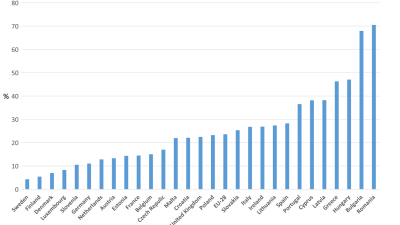The coalition government has reiterated its commitment to end child poverty in the UK by 2020 through tackling what it calls the underlying causes of deprivation. It has launched a consultation seeking views on what further action is needed to meet the target – but its plans to offer a revised measure of child poverty appear to have been shelved.
Consultation on the draft strategy will run until 22 May 2014, and the final strategy will be published once responses have been considered.
Key points
- Between November 2012 and February 2013, the coalition consulted over possible alternative measures of child poverty – measures that did not focus solely on income, but included a range of other factors such as the incidence of drug dependency in parents. The government notes that nearly 60 per cent of respondents agreed that a new measure of child poverty should go wider than income.
- Nonetheless, the latest draft strategy contains no proposals for a new measure. Instead the government has reiterated its commitment to the existing target on child poverty, which it suggests is measured purely on the basis of income (on the main measure, children are considered to be in relative poverty if they live in a household where total income is below 60 per cent of the median).
- The strategy sets out the action the coalition government will take over the period 2014-2017 to tackle poverty through: supporting families into work and increasing their earnings; improving living standards; and preventing poor children becoming poor adults through raising their educational attainment.
- The government claims that in many areas 'good progress' has been made in tackling child poverty. It cites the fact that since 2010 the number of children under 16 in workless households has fallen by 274,000. It also says that poor children are doing 'better than ever' at school.
- Nonetheless, the document says that more needs to be done to tackle the 'root causes' of child poverty, which it identifies as either worklessness or low earnings (either not working enough hours or not being paid enough).
Secretary of State for Work and Pensions, Iain Duncan Smith, said: 'We restate our commitment to tackling poverty at its source – be it worklessness, family breakdown, educational failure, addiction, or debt. These are the problems that blight the lives of vulnerable families and the strategy draws together the action we are taking on all these fronts'.
The Child Poverty Action Group expressed disappointment that the strategy contained little that was likely to make a difference to the child poverty figures. Citizens Advice called the lack of action on child poverty 'unacceptable'. The Children's Society said the strategy document was a 'wasted opportunity'. Action for Children pointed out that, despite the renewed commitment to abolish child poverty, the number of children below the breadline was actually set to rise to 4.7 million by the 2020 target date.
Alongside the draft strategy, the coalition government published a 130-page evidence review looking at the drivers of child poverty.
Source: Consultation on the Child Poverty Strategy 2014-17, Cm 8782, Department for Work and Pensions, TSO | An Evidence Review of the Drivers of Child Poverty for Families in Poverty Now and for Poor Children Growing Up to Be Poor Adults, Cm 8781, Department for Work and Pensions, TSO
Links: Evidence review | Hansard | DWP press release | Action for Children press release | Childrens Society press release | Citizens Advice press release | CPAG press release | CSJ press release | Gingerbread press release | IPPR blog post | JRF press release | NCB press release | BBC report | Daily Mail report | Guardian report (1) | Guardian report (2) | Guardian report (3) | Inside Housing report | New Statesman report | Public Finance report | Telegraph report | Jonathan Bradshaw comment



 PSE:UK is a major collaboration between the University of Bristol, Heriot-Watt University, The Open University, Queen's University Belfast, University of Glasgow and the University of York working with the National Centre for Social Research and the Northern Ireland Statistics and Research Agency. ESRC Grant RES-060-25-0052.
PSE:UK is a major collaboration between the University of Bristol, Heriot-Watt University, The Open University, Queen's University Belfast, University of Glasgow and the University of York working with the National Centre for Social Research and the Northern Ireland Statistics and Research Agency. ESRC Grant RES-060-25-0052.






